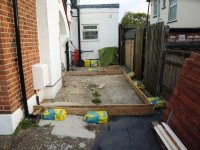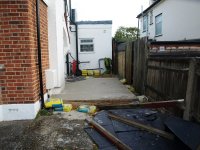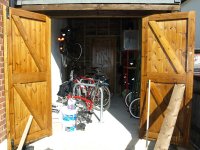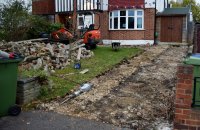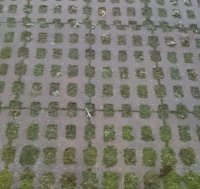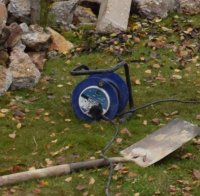Amarillo
Tom
Super Poster
VIP Member
My drive is in a lamentable condition The concrete is cracked, and the retaining wall is at an angle of about 8 degrees to the vertical. The subsoil is London clay.
See photo below

We have taken the decision to have a new driveway built which will be sufficiently wide for the van and a car side by side using just one exit to avoid the need for planning consent.
I have drawn up a design for the new front garden for the contractors which shows four distinct areas:
1. Drive area
2. Patio area
3. Lawn area
4. Flower beds
The drive area will be kerbed to the patio area, and I have tried to plan it so that when the wheels of the Beach hit the kerb at the back, there will be sufficient space for a VW Polo or similar sized car to reverse in side by side with the Beach.
See below:

The vehicle footprints are to scale, as are the positions of the wheels on the Beach. (Ignore the block paving colours - the colour will be brindle).
Does it appear that there is sufficient space to reverse a small car side by side with the van easily, or will the campervan need to be parked further back?
Each of the curves are an arc of 45 degrees with a 4m radius. The wall-wall turning circle of a California is 11.9m, I am unclear if that includes wing mirrors or not: perhaps someone know the answer... If wing mirrors are included, the turning circle of the centre of the vehicle will be a radius of 4.8. The wall-wall turning circle of a VW Polo is 10.6m implying a central turning radius of 4.35m.
Given these turning radii, is 4m a sensible radius for the arcs?
See photo below

We have taken the decision to have a new driveway built which will be sufficiently wide for the van and a car side by side using just one exit to avoid the need for planning consent.
I have drawn up a design for the new front garden for the contractors which shows four distinct areas:
1. Drive area
2. Patio area
3. Lawn area
4. Flower beds
The drive area will be kerbed to the patio area, and I have tried to plan it so that when the wheels of the Beach hit the kerb at the back, there will be sufficient space for a VW Polo or similar sized car to reverse in side by side with the Beach.
See below:

The vehicle footprints are to scale, as are the positions of the wheels on the Beach. (Ignore the block paving colours - the colour will be brindle).
Does it appear that there is sufficient space to reverse a small car side by side with the van easily, or will the campervan need to be parked further back?
Each of the curves are an arc of 45 degrees with a 4m radius. The wall-wall turning circle of a California is 11.9m, I am unclear if that includes wing mirrors or not: perhaps someone know the answer... If wing mirrors are included, the turning circle of the centre of the vehicle will be a radius of 4.8. The wall-wall turning circle of a VW Polo is 10.6m implying a central turning radius of 4.35m.
Given these turning radii, is 4m a sensible radius for the arcs?



